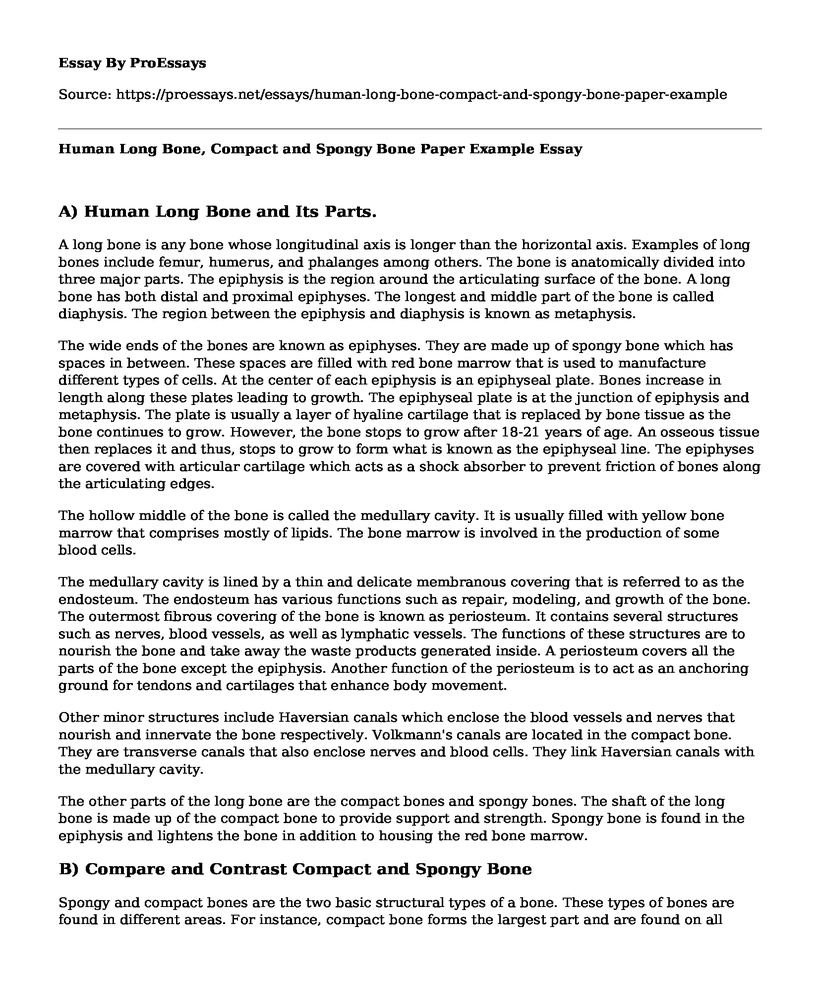A) Human Long Bone and Its Parts.
A long bone is any bone whose longitudinal axis is longer than the horizontal axis. Examples of long bones include femur, humerus, and phalanges among others. The bone is anatomically divided into three major parts. The epiphysis is the region around the articulating surface of the bone. A long bone has both distal and proximal epiphyses. The longest and middle part of the bone is called diaphysis. The region between the epiphysis and diaphysis is known as metaphysis.
The wide ends of the bones are known as epiphyses. They are made up of spongy bone which has spaces in between. These spaces are filled with red bone marrow that is used to manufacture different types of cells. At the center of each epiphysis is an epiphyseal plate. Bones increase in length along these plates leading to growth. The epiphyseal plate is at the junction of epiphysis and metaphysis. The plate is usually a layer of hyaline cartilage that is replaced by bone tissue as the bone continues to grow. However, the bone stops to grow after 18-21 years of age. An osseous tissue then replaces it and thus, stops to grow to form what is known as the epiphyseal line. The epiphyses are covered with articular cartilage which acts as a shock absorber to prevent friction of bones along the articulating edges.
The hollow middle of the bone is called the medullary cavity. It is usually filled with yellow bone marrow that comprises mostly of lipids. The bone marrow is involved in the production of some blood cells.
The medullary cavity is lined by a thin and delicate membranous covering that is referred to as the endosteum. The endosteum has various functions such as repair, modeling, and growth of the bone. The outermost fibrous covering of the bone is known as periosteum. It contains several structures such as nerves, blood vessels, as well as lymphatic vessels. The functions of these structures are to nourish the bone and take away the waste products generated inside. A periosteum covers all the parts of the bone except the epiphysis. Another function of the periosteum is to act as an anchoring ground for tendons and cartilages that enhance body movement.
Other minor structures include Haversian canals which enclose the blood vessels and nerves that nourish and innervate the bone respectively. Volkmann's canals are located in the compact bone. They are transverse canals that also enclose nerves and blood cells. They link Haversian canals with the medullary cavity.
The other parts of the long bone are the compact bones and spongy bones. The shaft of the long bone is made up of the compact bone to provide support and strength. Spongy bone is found in the epiphysis and lightens the bone in addition to housing the red bone marrow.
B) Compare and Contrast Compact and Spongy Bone
Spongy and compact bones are the two basic structural types of a bone. These types of bones are found in different areas. For instance, compact bone forms the largest part and are found on all parts of the bone. They make up the outside layer of all the skeletal bones. Spongy bones are usually located at the epiphyses of long bones. They also fill the cavities of some irregular bones. Hence, one of the similarities is that both comprise parts of a bone. However, they are found in different places of a bone.
Compact and spongy bone comprises the major types of osseous tissue. Spongy bone is also referred to as cancellous bones. On the other hand, compact bones are also referred to as cortical bones.
The structure of the two types of bones is also different. Several osteons make up the compact bone. These osteons are also known as Haversian systems. They are rod-like structures that form the outer part of the long bones. Haversian canals pass through this osteons and act as pathways for blood vessels and nerves. They also carry with them lymphatic vessels for draining lymph fluid from the bones.
On the other hand, the structures that make up spongy bones are known as trabeculae. They appear like thin threads. Besides, they are lighter than osteons.
Spongy bones contain spaces that are occupied by red bone marrow. For this reason, they are weak as compared to compact bones. Compact bones only contain canals for nerves and blood vessels. Therefore, they are very strong but brittle.
Compact bones are extremely tough and are heavy as compared to spongy bones. They are stacked in several layers. The compact bone accounts for between 75 and 80 percent of the total weight of a bone, and thus, the skeleton. In contrast, spongy bones are very light because of the spaces in between.
The two types of bones are made up of the same type of cells, osteoclasts, osteocytes, and osteoblasts. The only difference between them is on how the cells are arranged to form a bone.
Work Cited
Rizzo, Donald C. Fundamentals of anatomy and physiology. Cengage Learning, 2015.
Cite this page
Human Long Bone, Compact and Spongy Bone Paper Example. (2022, Aug 10). Retrieved from https://proessays.net/essays/human-long-bone-compact-and-spongy-bone-paper-example
If you are the original author of this essay and no longer wish to have it published on the ProEssays website, please click below to request its removal:
- Can Apes Learn Language?
- Keeping Animals in Zoos Should Be Banned for Life - Essay Sample
- Essay Sample on Digestive and Respiratory System
- Underweight, Skinfold and Bioelectrical Impedance Essay Example
- Research Paper on Extinction & Endangered Species: A Human-Catalyzed Catastrophe
- Essay Sample on Humans-Environment Interactions: A Constant Struggle for Survival
- Free Essay Sample on Natural Capital: Essential for Human Survival







